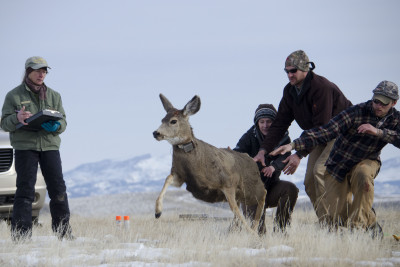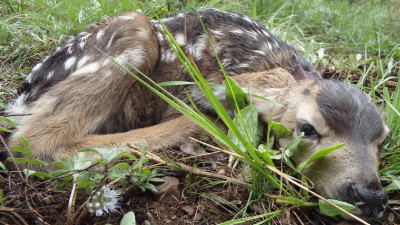 Research on the Wyoming Range Mule Deer Project led to the discovery of an unexpected killer of young mule deer in western Wyoming. Dr. Kevin Monteith along with researchers of the Monteith Shop and the Wyoming State Vet Lab found that 23% of all fawn mortalities documented between June and November 2015 were caused by adenovirus hemorrhagic disease (AHD). AHD is a viral disease that was first discovered in California in the early 1990’s. Currently, little is known about AHD, but future research will be focused on understanding the impact this disease may have on mule deer populations in Wyoming. These findings resulted from a component of the Wyoming Range Mule Deer Project which is aimed at disentangling the effects of predation, nutrition, and habitat on survival of neonatal mule deer. Other components of the project are aimed at investigating the effects of human disturbance on the nutritional ecology of mule deer and evaluating phenology tracking by migratory mule deer.
Research on the Wyoming Range Mule Deer Project led to the discovery of an unexpected killer of young mule deer in western Wyoming. Dr. Kevin Monteith along with researchers of the Monteith Shop and the Wyoming State Vet Lab found that 23% of all fawn mortalities documented between June and November 2015 were caused by adenovirus hemorrhagic disease (AHD). AHD is a viral disease that was first discovered in California in the early 1990’s. Currently, little is known about AHD, but future research will be focused on understanding the impact this disease may have on mule deer populations in Wyoming. These findings resulted from a component of the Wyoming Range Mule Deer Project which is aimed at disentangling the effects of predation, nutrition, and habitat on survival of neonatal mule deer. Other components of the project are aimed at investigating the effects of human disturbance on the nutritional ecology of mule deer and evaluating phenology tracking by migratory mule deer.
The Casper Star Tribune recently published an article about the recent findings of the Wyoming Range Mule Deer Project. The article, written by Christine Peterson, can be read on the paper’s website.
Wyoming Public Media also posted an article about the Wyoming Range Mule Deer Project. The article, written by Melodie Edwards, can be read at wyomingpublicmedia.org.
http://wyomingpublicmedia.org/post/mule-deer-fawns-dying-rare-disease-wyoming-range
Funding for understanding survival of mule deer fawns of the Wyoming Range was largely provided by Wyoming Wildlife and Natural Resource Trust, and the Animal Damage Management Board. Financial support also comes from the Bureau of Land Management, the Wyoming Game and Fish Department, the Muley Fanatic Foundation, the Wyoming Governor’s Big Game License Coalition, the Wyoming Game and Fish Commissioner License, and Bowhunters of Wyoming.



